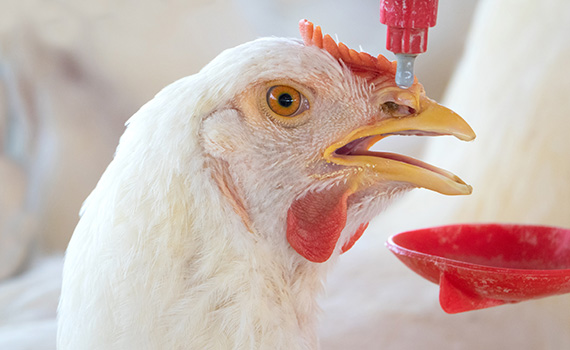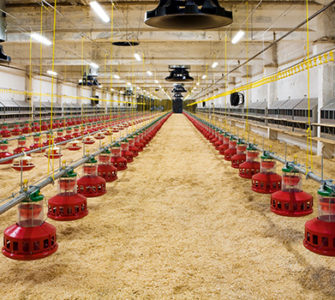Intestinal health in the era of NAE
By Tom Tabler, PhD
Extension Professor
Mississippi State University Extension Service, Poultry Science Department
Mississippi State, Mississippi
The vital role the gastrointestinal tract (GIT) plays in nutrient absorption and the immune response is probably much more complex and dynamic than most of us realize. We do know, however, that maintaining good intestinal health and minimizing intestinal disruptions are critical to growth, to the health and welfare of birds and to the food safety aspects of modern-day poultry production.
This is especially true for no antibiotics ever (NAE) production systems. If digestion and nutrient absorption are compromised, an overgrowth of intestinal microbes can occur that, in turn, affect bird health and performance. Although poultry companies with NAE flocks are turning to antibiotic alternatives to promote good gut health — pre-and probiotics, essential oils, enzymes, etc. — a properly functioning GIT is essential to achieve positive results with dietary manipulations.
Feed and water
One of the most basic tenets for maintaining good intestinal health in NAE flocks is good quality feed and water. In fact, feed and water quality need to be superior.
I advise producers with NAE flocks to make sure they have quality feed and to make sure they never run out of feed. It takes only a few hours without feed for the gut mucosa to shift, making birds more susceptible to enteritis. Feed withdrawal stimulates mucin production by goblet cells in the intestinal mucosa. This extra mucin is then used by bacteria to irritate the mucosa and generate inflammatory reactions.
Good drinking water quality is likewise critically important for NAE flocks. Much of my extension work today is focused on well water quality for poultry farms growing NAE birds. The mineral concentration, bacterial load and pH of the water needs to be monitored. Water hardness, alkalinity and a high pH can disturb crop pH and reduce the early phase of digestion, bacteria can cause disease and threaten flock health, while a low pH can irritate the intestinal lining.
Water quality is not only important for good digestion, it can minimize microbial proliferation in water lines, nipples and drinker systems. Failure to monitor and ensure water quality on the farm can be detrimental to intestinal health and bird performance.
Breeder health
Something that I think too often gets overlooked in an NAE program is the key role that breeder health, nutrition and welfare plays in producing a healthy broiler chick. Feed and water quality for breeders are just as important as they are for broilers. Loose droppings and wet litter are just as bad in a breeder house as they are in a broiler house.
Eggs going to the hatchery must be CLEAN to limit the bacterial load entering the hatchery. Hatcheries must also be CLEAN if they are going to hatch quality baby chicks. Incubation temperatures are critical to chick quality at hatch. Suboptimal incubation tends to increase the hatch window by causing some chicks to hatch either too early or too late. This results in problems with development of the lymphoid tissue associated with the intestines.
Gut disease
I often see multiple issues at the same time on farms with NAE flocks when intestinal health is compromised by coccidiosis and necrotic enteritis. Irritated intestinal linings often result in loose droppings and excess feed passage, in turn leading to wet floors. Excess feed passage results in a poor growth rate and high feed conversion ratios. Wet floors can lead to increased ammonia levels and eye irritations, increased footpad issues and poor paw quality.
For intestinal health to be maintained in today’s NAE era, coccidiosis and necrotic enteritis must be controlled. In NAE programs that do not allow anticoccidal medications, this is done mainly with coccidiosis vaccines and improved litter management.
In addition, within the GIT, there are numerous interactions taking place between the bird’s intestinal cells, bacterial cells within the intestines and feed components. Hopefully, the bacterial population forms a protective lining over the gut wall, thus restricting or preventing growth of pathogenic bacteria such as Clostridium perfringens (the troublemaker responsible for necrotic enteritis), Salmonella and Campylobacter. This is often called competitive exclusion but what it really means is that the good bugs, for the most part, fight off the bad bugs.
Fight the problem, not the consequences
There are many times when we get the cart before the horse when it comes to intestinal health. When we have an intestinal health issue such as coccidiosis or necrotic enteritis, we tend to focus on controlling intestinal disease. This is understandable because we see coccidiosis or necrotic enteritis and realize we have a problem.
However, while coccidiosis and necrotic enteritis are certainly a problem, they are not the problem. The real problem is often an excess of nutrients that caused a proliferation of microbes, leading to coccidiosis and necrotic enteritis.
In the past, small amounts of antibiotic reduced the number and diversity of certain microbes and created enteric conditions with fewer bad bacteria. As a result, intestinal health issues were better held in check. Today, antibiotics (for the most part) are gone and microbes are better able to proliferate and cause problems. However, microbes have always been here and will continue to be here.
Our first concern should be addressing the reduction in digestion or the excess in undigested nutrients in the GIT that is allowing the microbes to upset the intestinal equilibrium. Why is this happening and how do we fix it?
Balancing act
Intestinal health relies on maintaining a balance between the host, the microbes, the intestinal environment and dietary compounds. When intestinal health is optimal, we see near complete digestion of the feed and absorption of feed nutrients. When intestinal health is suboptimal, malabsorption and a gut imbalance are likely because of incomplete digestion. This can result in an overgrowth in the microbial population and a shift away from beneficial bacteria. So now, the bad bugs are fighting off the good bugs.
When I necropsy birds, I pay special attention to the GIT both inside and outside. Even if the problem is a respiratory issue or an Escherichia coli infection and not an actual intestinal health issue, I still closely examine the GIT. I look at the crop, the proventriculus and the gizzard. In the intestinal tract, I’m looking for signs of coccidiosis and necrotic enteritis. I’m looking to see if the intestinal walls are thin. I look for worms. I check the viscosity of intestinal contents, the ceca and the color of the intestine itself. Anything out of the ordinary is a red flag.
Obviously, there are a wide variety of factors that can affect intestinal health. Besides feed and water, hatchery conditions and egg pack cleanliness, they include farm management, the housing environment as well as biosecurity on both breeder and broiler farms. We must improve in all of these areas if we expect to have successful NAE programs in the future.
Compared to just 3 to 5 years ago, we have a much better understanding that any negative impact on gut health — disease related or not — negatively affects performance and welfare. Poultry companies are learning to overcome challenges associated with NAE production by refining their nutritional programs, adopting the latest technologies and by altering animal husbandry practices.
Converting from conventional to NAE production can be done although it comes with reduced efficiency and increased production costs. Sustaining NAE production is also possible — but it’s going to largely depend on how well we understand and manage intestinal health.
Editor’s note: The opinions and advice presented in this article belong to the author and, as such, are presented here as points of view, not specific recommendations by Poultry Health Today.
Posted on August 13, 2020

















